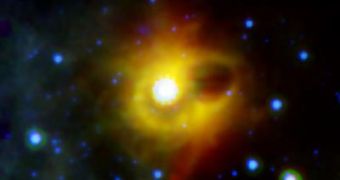In 2005 and 2007, NASA Spitzer Space Telescope detected two narrow infrared signatures near the magnetar dubbed SGR 1900+14, suggesting that the star was surrounded by a ring of matter that remained in its vicinity after the progenitor star went 'nova'. SGR 1900+14 is a neutron star with a magnetic field a trillion times more powerful than that of Earth and a soft gamma repeater, meaning that it regularly generates gamma-ray bursts.
Now, a team of astrophysicists from the University of Chicago are trying to understand why the ring of matter is still around the dead star. "The universe is a big place, and weird things can happen. I was flipping through archived Spitzer data of the object, and that's when I noticed it was surrounded by a ring we'd never seen before", said Stephanie Wachter from NASA's Spitzer Science Center at the California Institute of Technology.
So, along with Vikram Dwarkadas from the University of Chicago's Wachter, she started investigating how the seven light years across ring of matter formed around the SGR 1900+14 magnetar. "It's the first time something like this has ever been seen around a magnetar. These stars are at least eight times the mass of the sun, or more massive than that", Dwarkadas said.
Magnetars are basically neutron stars. When massive stars explode in supernovae, their cores collapse to form either neutron stars or black holes. Some of the newly formed neutron stars exhibit extremely powerful magnetic fields, albeit why this is happening remains largely a mystery. Since SGR 1900+14 appears to be part of a cluster of massive stars in the galactic plane of the galaxy, which would suggest that only very massive stars get to become magnetars, while stars with masses even larger than that would ultimately form black holes.
But this would still not explain why the ring of matter is around the dead star. "We thought initially of all the standard explanations", Dwarkadas said. Thus the team started considering the possibility that it is in fact a powerful flare created by the magnetar itself. "It's as if the magnetar became a huge flaming torch and obliterated the dust around it, creating a massive cavity. Then the stars nearby lit up a ring of fire around the dead star, marking it for eternity", said Chryssa Kouveliotou from NASA's Marshall Space Flight Center.
However, in order to test this theory, several other premises had to be eliminated. The ring could be just as well a mass of dust lit by a flare from the magnetar, which was emitting an infrared echo or a bubble generated by the progenitor star before the supernova explosion. But Spitzer showed no visible change in its two observations during 2005 and 2007. "If it hasn't moved, it hasn't changed, it can't be an infrared echo. It's a stationary ring", Dwarkadas said.
Alternatively, the bubble would have been reached by now by the shock wave of the explosion, traveling at 16,000 kilometers per second.
"It would mean that the supernova should have actually gone through and destroyed the ring unless it was very, very recent. In order for the bubble to survive the shock waves, you'd need a massive bubble. We did some calculations and we ran some simulations, and it just didn't work", said Dwarkadas.
Then, the team started wondering whether or not it may be linked to the supernova. "If there is a supernova, there would be shocks. You would see X-ray, radio and optical emission. We looked at archival data, and there was no emission at any wavelength except in the Spitzer images", said Dwarkadas.

 14 DAY TRIAL //
14 DAY TRIAL //